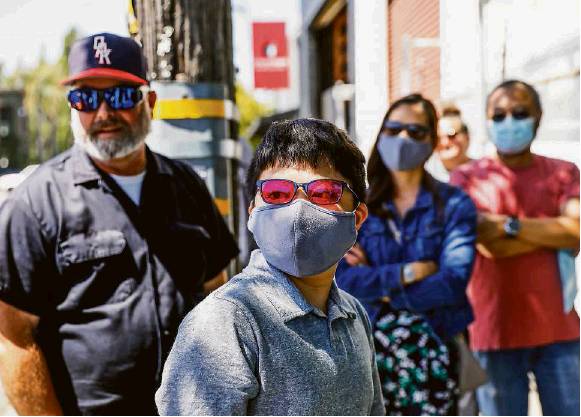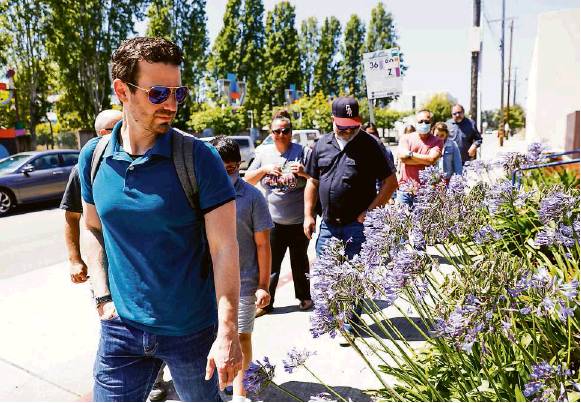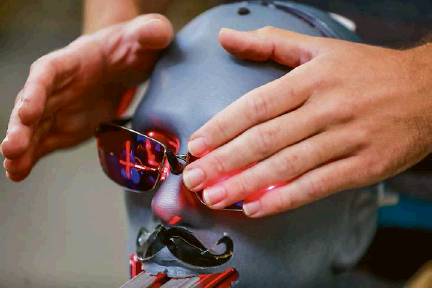Berkeley company opens eyes to color
Lens technology helps wearers perceive more hues
By Carolyn Said
Three colorblind guys, wearing special glasses to enable them to perceive new hues, gazed at the vibrant mural on a Berkeley building and took turns lifting their glasses to see it with their naked eyes.
“This green I would’ve said was yellow,” said Matt McDonell, 50.
“These two, the pink and purple, both look the same,” said Benjamin Kai Lee, 11.
“With the glasses, this green is so green,” said Marc Pasquinelli,
38.
The trio were wearing eyeglasses from EnChroma, an 11-year-old Berkeley company that says its patented lens technology allows people with red-green colorblindness — the most common type — to perceive colors that otherwise would appear washed out or muddy.
“Our product can be life-changing,” said EnChroma CEO Erik Ritchie. “Many colorblind people don’t realize there’s a solution; it’s just something they’ve always had to deal with.”
Benjamin, an Antioch resident, got the glasses a year ago on his 10th birthday. His father covered his eyes and walked him to the bathroom, where his mom was holding several colorful balloons. He put on the glasses and was able to distinguish the various colors.
“I was like, ‘Oh, they’re so bright,’ ” he recalled. Without the glasses, “they just blended together into one color or were like darkened versions of themselves.”
Some 350 million people worldwide and 13 million in the U.S. — 1 in 12 men, and 1 in 200 women — experience colorblindness, meaning they see a diminished range of the over 1 million hues and shades perceived by other people. To them, colors may appear washed out and hard to differentiate.
They can face a myriad of everyday challenges: What color is the stoplight? Is this curb red? Do my clothes match today? Is this fruit ripe?
“I still get excited when I put them on and walk around.”
Marc Pasquinelli on wearing EnChroma glasses for colorblindness
Oakland resident McDonell has had varied jobs in fields that can be challenging for someone who struggles to perceive color.
He enlisted in the Marine Corps Reserve but wasn’t allowed to handle ammunition because it’s color-coded, so he was a Humvee operator and radio operator. When McDonell worked as a deputy harbormaster and had to issue parking tickets, he’d text photos to his wife so she could tell him the cars’ color.
When he worked to fight fires, “being colorblind didn’t impact it,” he said. “All we care about is can you see smoke.” But for the emergency medical technician part of the job, McDonell sometimes needed to know if someone’s skin was flushed or reddened.
Now as a supervisor at the East Bay Regional Parks, he carries a can of white spray paint to mark areas where water, gas or electricity are buried underground, rather than relying on the color marking ordinarily used.
He and his wife, Sandy, got married in Oakland’s Rose Garden. McDonell went back there with the EnChroma glasses, “and it was pretty amazing,” he said. “I thought redwood tree trunks were brown; I had no idea they were actually red.”
Pasquinelli of San Francisco, a facilities manager, said his colorblindness was a hindrance when he worked at a stationery store and needed to match colored tissue paper, for instance.
“Purple was always my Achilles heel,” he said. “It looks just like muddy blue. Pink sometimes looks like gray. I’ll put on the glasses and I’m like, ‘Oh my gosh — cherry blossoms!’ I didn’t realize the green in streetlights was so green, it looked minty, almost off-white to me. That was a trip.”
John Werner, a UC Davis professor of ophthalmology and neuroscience, said that glasses for colorblind people have existed for years but that most don’t work well in real-life situations. Instead, they allow colorblind people to pass the Ishihara test, in which an array of colored dots surround a number or symbol composed of dots in a contrasting color that colorblind people cannot tell is contrasting.
Werner co-authored a study published in Current Biology of colorblind people who wore EnChroma glasses and discovered that after a couple weeks of use, participants had better color vision even without the glasses.
“I’m not saying it was normal, but they could see colors they couldn’t see before,” he said. “It was a perceptual learning; it trains the brain.”
Werner himself is red-green colorblind and was initially skeptical of EnChroma’s claims. “But it really is quite remarkable,” he said. “I wear them all the time and love them.”
EnChroma glasses range from $189 to $349, depending on the frame, with different ones for indoors and outdoors use. They can also be made with wearer’s prescriptions. Insurance sometimes covers the cost. The company sells most through its website but also has optometrists who carry the glasses.
The company is on a mission to spread awareness of colorblindness — and of its product. It’s encouraging schools to test children for the condition early. It’s sold discounted glasses to museums, state parks, libraries and school districts for use by their visitors and students.
“I still get excited when I put them on and walk around,” Pasquinelli said. “In an art gallery or a place with a lot of flowers, it is so cool. It’s much richer with the outdoor lenses; like watching the world in Technicolor.”
Benjamin chimed in with a tween’s perspective on the venerable movie innovation.
“What’s Technicolor?” he asked.
Carolyn Said is a San Francisco Chronicle staff writer. Email: csaid@sfchronicle.com Twitter: @csaid



